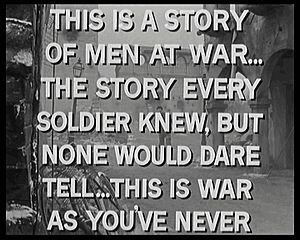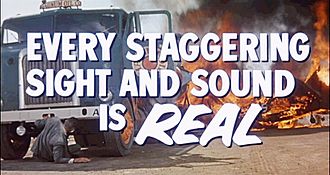Trailer (promotion) facts for kids
A trailer is a short video that advertises something, usually a feature film that will be shown in movie theaters soon. It's like a sneak peek to get people excited!
Trailers are not just for movies anymore. You can find them for DVDs, Blu-rays, and online. They are very popular on the internet, ranking high among all videos watched online. The idea of a trailer is also used to promote TV shows, video games, books, and even concerts.
Contents
History of Trailers
The very first trailer shown in an American movie theater was in November 1913. A man named Nils Granlund, who worked for the Marcus Loew theater chain, made a short video to promote a musical called The Pleasure Seekers. This was a new and unique idea at the time! Granlund also used slides to promote a Charlie Chaplin film in 1914.
Trailers were first shown *after* the main movie. This is why they are called "trailers" – because they trailed, or came after, the film. But people often left the theater right after the movie, so this wasn't very effective. Later, theaters started showing trailers *before* the main film, along with cartoons and newsreels. Today, trailers and other ads often fill the first 20 minutes before a movie starts in big theaters.
Until the late 1950s, trailers often showed key scenes from the movie with big text explaining the story. They also had narrators with strong voices. This style changed in the 1960s. Trailers started using quick cuts and montages (a series of short clips put together). Directors like Stanley Kubrick helped make this new style popular with his trailers for films like Lolita and 2001: A Space Odyssey. Pablo Ferro created some of these famous trailers.
Many home videos (like VHS tapes, DVDs, and Blu-rays) also include trailers for other movies. This helps companies advertise their films without spending money on TV ads. With streaming and mobile devices, trailers can be a bonus feature you choose to watch.
In 1993, movie studios started putting trailers online. Companies like Walt Disney Company and Columbia Pictures made trailers available for download to computer users.
Since the mid-2010s, many trailers now start with a very short 5- to 10-second preview of the trailer itself. This is sometimes called a "micro-teaser." It's meant to quickly grab your attention so you don't skip the full trailer on streaming sites.
What is a Trailer?
Trailers are made up of selected shots from the movie they are advertising. Their main goal is to get people interested in seeing the film. So, these clips usually show the most exciting, funny, or important parts of the movie. But they are careful not to give away too much of the story or any major spoilers. The scenes in a trailer are not always in the same order as they appear in the movie.
Movie trailers have a maximum length of 2 minutes and 30 seconds, set by the MPA. However, each studio can go over this limit once a year if they feel it's really needed for a special film. In 2014, movie theaters asked distributors to make trailers no longer than two minutes, but this is just a suggestion, not a strict rule.
Some trailers use "special shoot" footage. This means material created just for the advertisement that is not actually in the final movie. A famous example is the trailer for Terminator 2: Judgment Day, which showed a robot being built in a factory. This scene was made just for the trailer and wasn't in the movie. Another example is the trailer for Spider-Man, which had an action scene with bank robbers caught in a web between the World Trade Center towers. This trailer was removed after the September 11 attacks.
One of the most well-known "special shoot" trailers is for the 1960 thriller Psycho. In it, director Alfred Hitchcock gives a tour of the Bates Motel. He pulls back a shower curtain to reveal a screaming woman. This scene was filmed after the movie was finished, and a different actress was used for the trailer!
Many companies specialize in making film trailers. They often work on trailers while the movie itself is still being edited. This means the trailer might include footage or music that doesn't end up in the final film. Composers for movie scores are usually hired much later, so trailer music often comes from other sources.
Collectors sometimes look for trailers that contain material not in the final film. For example, a trailer for Casablanca has a line of dialogue that isn't in the movie.
Misleading Trailers
Sometimes, trailers can give a wrong idea about a movie. They might make a small role seem like a main character, or make a movie seem more action-packed than it is. These tricks are usually used to attract more viewers. Sometimes, footage not from the film is included. This might be an artistic choice or because the trailer was made before the final movie was ready. But sometimes, it's done to give the audience a different impression of the movie.
For example, a woman sued the makers of the film Drive because she felt the movie didn't match what the trailer promised. In 2016, a lawyer tried to sue Suicide Squad because it didn't include enough scenes with the Joker that were shown in the trailer.
How Trailers Are Made
Trailers tell the story of a film in a very short way to make it as appealing as possible. Over the years, making trailers has become a big industry. They are now very polished advertisements that can make even a not-so-great movie look exciting. Trailers are usually made from scenes in the movie, but sometimes they include deleted scenes that were cut from the final film.
The main goal when making a trailer is to tell an interesting story that makes people feel something and want to see the movie.
Most trailers have a three-part structure, just like a full-length movie.
- Part 1 (Beginning): This part sets up the basic idea of the story.
- Part 2 (Middle): This part moves the story forward and often ends with an exciting moment.
- Part 3 (End): This part usually features strong "signature music" (a well-known song or powerful orchestral piece). It often shows a quick montage of exciting and emotional moments from the film. It might also list the main actors if they are famous stars who can help sell the movie.
Sometimes, a voice-over narrator is used to quickly explain the movie's idea. This helps the audience understand the plot better, especially since trailers are so short. In the past, Hollywood trailers were known for using big words like "Colossal!" or "Stupendous!"
Music is very important for setting the tone and mood of a trailer. The music used in a trailer is usually not from the movie's actual film score, because the score might not even be composed yet! The music in trailers can be:
- Music from the scores of other movies.
- Popular or well-known songs, chosen for their mood or lyrics. A very common piece of music used is O Fortuna from Carmina Burana.
- "Library" music, which is music created specifically for advertising by independent composers.
- Music specially composed for the trailer. John Beal is a famous composer who has created original music for over 2,000 film trailers, including for movies like Star Wars and Titanic.
A cast run is a list of the main stars in the movie. If the director or producer is famous, they might be mentioned too. Most trailers end with a billing block, which is a list of the main cast and crew. This is the same list you see on movie posters. Studio production logos are usually shown near the beginning of the trailer.
Trailers often use advanced sound mixing, like Dolby Digital, to make sound effects and music sound even better. Trailers shown in theaters are usually in the same format as the movie, like 35 mm film or a digital format. For 3-D movies, the trailers are also often shown in 3-D.
Trailer Collections
In the past, movie theaters were supposed to return or destroy trailers after use. But many trailers were saved and sold to collectors because they had commercial value. For example, trailers for the Star Wars series that were reported as "destroyed" were often taken and sold by cinema staff.
Some cinemas also started showing "trailer trash" programs, which were just collections of trailers without a main movie. You can also find DVDs that contain only trailers, often for older or unique films.
Other Types of Trailers
With the growth of the internet and sites like YouTube, and new animation techniques, it became easier and cheaper to make and show different kinds of trailers starting in the late 1990s and early 2000s.
Video Game Trailers
Video game trailers became very popular in the late 1990s and early 2000s to get people to buy games. There are two main types:
- Cinematic trailers: These are usually made with CGI and look like short animated movies. They don't show actual gameplay.
- Gameplay trailers: These are made using the game's actual engine and show what the game looks like when you play it. However, sometimes even these trailers show graphics that are better than the final game, as seen with Cyberpunk 2077 and Aliens: Colonial Marines.
TV Spots
TV spots are short trailers for movies shown on television. They are usually 30–60 seconds long. They are made to be "appropriate" for the TV channel they are shown on.
TV Show Trailers
While not common at first, TV show trailers became a popular way to advertise in the late 2000s. They promote new TV series, upcoming episodes, special events, or marathons. Trailers for the next episode of a TV series are often shown during or after the credits of the current episode.
Book Trailers
A book trailer is a video advertisement for a book. It uses techniques similar to movie trailers to promote books and encourage reading. These videos can be simple, with still photos and music, or full productions with actors. They are different from author readings or interviews.
In 2007, the School Library Journal started the Trailie Award for the best book trailers. There are categories for trailers made by authors/publishers, students, and librarians/adults.
Fan-Made Trailers
For popular movies, fans often create their own trailers. These are unofficial videos made by fans using audio or video from the movie, official trailers, animation, or even scenes acted out by fans.
Awards for Trailers
Every year, there are two main events that give awards to great film trailers:
- The Key Art Awards, presented by The Hollywood Reporter.
- The Golden Trailer Awards.
These awards recognize excellence in all parts of film advertising, including trailers, TV spots, and posters. The Key Art Awards ceremony is often held at the Dolby Theatre in Hollywood.
|
See also
 In Spanish: Avance (publicidad) para niños
In Spanish: Avance (publicidad) para niños
- Key art
- Golden Trailer Awards
- Re-cut trailer
- Snipe (theatrical)
- Stinger (post-credits scene)
- Teaser trailer
- Trailer music
- Motion Picture Association film rating system § Theatrical trailers




